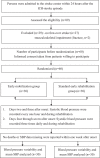Effects of early mobilization on short-term blood pressure variability in acute intracerebral hemorrhage patients: A protocol for randomized controlled non-inferiority trial
- PMID: 34032760
- PMCID: PMC8154506
- DOI: 10.1097/MD.0000000000026128
Effects of early mobilization on short-term blood pressure variability in acute intracerebral hemorrhage patients: A protocol for randomized controlled non-inferiority trial
Abstract
Background: Early out-of-bed mobilization may improve acute post-intracerebral hemorrhage (ICH) outcomes, but hemodynamic instability may be a concern. Some recent studies have showed that an increase in mean systolic blood pressure (SBP) and high blood pressure variability (BPV), high standard deviation of SBP, may lead to negative ICH outcomes. Therefore, we investigated the impact of an early mobilization (EM) protocol on mean SBP and BPV during the acute phase.
Methods: The study was an assessor-blinded, randomized controlled non-inferiority study. The participants were in An Early Mobilization for Acute Cerebral Hemorrhage trial and were randomly assigned to undergo EM or a standard early rehabilitation (SER) protocol within 24 to 72 hour after ICH onset at the stroke center. The EM and SER groups each had 30 patients. 24-measurement SBP were recorded on days 2 and 3 after onset, and SBP were recorded three times daily and during rehabilitation on days 4 through 7. The two groups' mean SBP and BPV under three different time frames (days 2 and 3 during the acute phase, and days 4 through 7 during the late acute phase) were calculated and compared.
Results: At baseline, the two groups' results were similar, with the exception being that the mean time to first out-of-bed mobilization after symptom onset was 51.60 hours (SD 14.15) and 135.02 hours (SD 33.05) for the EM group and SER group, respectively (P < .001). There were no significant differences in mean SBP and BPV during the acute and late acute phase between the two groups for the three analyses (days 2, 3, and 4 through 7) (P > .05).
Conclusions: It is safe to implement the EM protocol within 24 to 72 hour of onset for mild-moderate ICH patients during the acute phase.
Copyright © 2021 the Author(s). Published by Wolters Kluwer Health, Inc.
Conflict of interest statement
The authors have no conflicts of interest to disclose.
References
-
- Bernhardt J, English C, Johnson L, Cumming TB. Early mobilization after stroke: early adoption but limited evidence. Stroke 2015;46:1141–6. - PubMed
-
- Fuest K, Schaller SJ. Recent evidence on early mobilization in critical-Ill patients. Curr Opin Anaesthesiol 2018;31:144–50. - PubMed
-
- Bernhardt J, Dewey H, Thrift A, Collier J, Donnan G. A very early rehabilitation trial for stroke (AVERT): phase II safety and feasibility. Stroke 2008;39:390–6. - PubMed
-
- Langhorne P, Stott D, Knight A, Bernhardt J, Barer D, Watkins C. Very early rehabilitation or intensive telemetry after stroke: a pilot randomised trial. Cerebrovasc Dis 2010;29:352–60. - PubMed
Publication types
MeSH terms
Substances
LinkOut - more resources
Full Text Sources
Other Literature Sources


